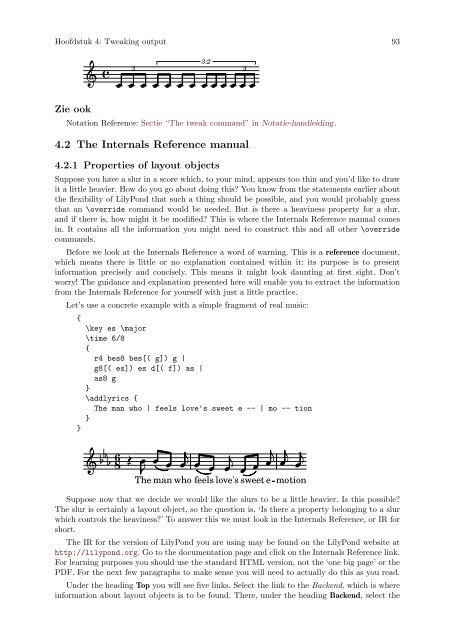LilyPond Beginnershandleiding
LilyPond Beginnershandleiding
LilyPond Beginnershandleiding
Create successful ePaper yourself
Turn your PDF publications into a flip-book with our unique Google optimized e-Paper software.
Hoofdstuk 4: Tweaking output 93<br />
Zie ook<br />
<br />
<br />
3<br />
<br />
3:2<br />
<br />
<br />
<br />
Notation Reference: Sectie “The tweak command” in Notatie-handleiding.<br />
4.2 The Internals Reference manual<br />
4.2.1 Properties of layout objects<br />
Suppose you have a slur in a score which, to your mind, appears too thin and you’d like to draw<br />
it a little heavier. How do you go about doing this? You know from the statements earlier about<br />
the flexibility of <strong>LilyPond</strong> that such a thing should be possible, and you would probably guess<br />
that an \override command would be needed. But is there a heaviness property for a slur,<br />
and if there is, how might it be modified? This is where the Internals Reference manual comes<br />
in. It contains all the information you might need to construct this and all other \override<br />
commands.<br />
Before we look at the Internals Reference a word of warning. This is a reference document,<br />
which means there is little or no explanation contained within it: its purpose is to present<br />
information precisely and concisely. This means it might look daunting at first sight. Don’t<br />
worry! The guidance and explanation presented here will enable you to extract the information<br />
from the Internals Reference for yourself with just a little practice.<br />
Let’s use a concrete example with a simple fragment of real music:<br />
{<br />
}<br />
\key es \major<br />
\time 6/8<br />
{<br />
r4 bes8 bes[( g]) g |<br />
g8[( es]) es d[( f]) as |<br />
as8 g<br />
}<br />
\addlyrics {<br />
The man who | feels love's sweet e -- | mo -- tion<br />
}<br />
8<br />
6<br />
<br />
3<br />
<br />
<br />
<br />
<br />
<br />
sweet<br />
The<br />
love's e<br />
<br />
man who feels<br />
<br />
<br />
motion<br />
Suppose now that we decide we would like the slurs to be a little heavier. Is this possible?<br />
The slur is certainly a layout object, so the question is, ‘Is there a property belonging to a slur<br />
which controls the heaviness?’ To answer this we must look in the Internals Reference, or IR for<br />
short.<br />
The IR for the version of <strong>LilyPond</strong> you are using may be found on the <strong>LilyPond</strong> website at<br />
http://lilypond.org. Go to the documentation page and click on the Internals Reference link.<br />
For learning purposes you should use the standard HTML version, not the ‘one big page’ or the<br />
PDF. For the next few paragraphs to make sense you will need to actually do this as you read.<br />
Under the heading Top you will see five links. Select the link to the Backend, which is where<br />
information about layout objects is to be found. There, under the heading Backend, select the



